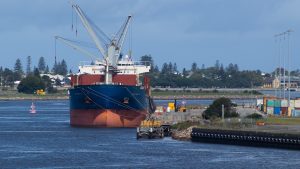China has escalated its military expansion in the southwest Pacific, with the People’s Liberation Army Navy (PLAN) conducting combat exercises in the Tasman Sea in February 2025. The drills, carried out with little warning in the waters between Australia and New Zealand, demonstrated the PLAN’s growing capabilities in long-range navigation, logistics, and reconnaissance. More critically, they revealed Beijing’s increasing confidence in its maritime situational awareness and far seas.
Some analysts linked China’s presence in the Tasman Sea to the AUKUS Pillar II meeting. Others saw it as a direct response to U.S., Australian, and New Zealand freedom of navigation operations in the Taiwan Strait and South China Sea. But the message is more than that: China wants to rule the waves in the Pacific and to force Australia and New Zealand to accept the new order.
In my new policy paper “China’s Dual-Use Infrastructure in the Pacific,” published as part of the Coastwatchers 2.0 Project, I argue that China’s moves reflect a long-term strategy for regional dominance. China embeds its military ambitions within Pacific Island nation Belt and Road Initiative (BRI) projects by developing dual-use infrastructure such as ports, wharves, fisheries, aviation hubs, and ICT networks. These assets strengthen PLA operations while remaining disguised as civilian investments.
The PLAN now commands the world’s largest navy, with 400 battle-force ships in 2025 and projections of 425 by 2030. Its activities increasingly extend beyond the First Island Chain toward the Third Island Chain and even South America. The Tasman Sea exercises highlighted Beijing’s intent to break through traditional containment lines and shift the regional balance of power. Dual-use infrastructure plays a key role in this strategy.
My report identifies nine ports and wharves, two fishery facilities, 17 aeronautical projects, and 14 ICT infrastructures tied to Chinese enterprises – most of them state-owned and linked to the defense sector. These projects create a dual-use ecosystem that enhances PLA capabilities across the region.
China avoids scrutiny of its strategic goals in the Pacific through three approaches. First, it markets these projects as drivers of local economic growth. Evidence shows otherwise: larger wharves or airstrips rarely increase vessel traffic or flight operations. Second, Chinese firms dominate Pacific infrastructure contracts funded by organizations like the Asian Development Bank (ADB) and World Bank. This tactic shifts financial responsibility to international bodies while masking Beijing’s intentions. Third, China plays a long game with low-profile investments. Huawei’s fiber-optic network in Vanuatu has operated since 2008, embedding Chinese technology into critical infrastructure over time with minimal oversight.
The affiliations between Chinese contractors and defense entities raise additional concerns. China Merchants Port Holdings owns a 50 percent stake in the Port of Newcastle near Royal Australian Air Force (RAAF) Base Williamtown and Port Kembla – a potential site for AUKUS nuclear submarines. The company collaborates with state-owned defense contractors like China Electronics Technology Group Corporation and works closely with Huawei and Tencent, both designated as Chinese military companies by the United States. Sensitive geospatial data from the Port of Newcastle likely flows directly to Beijing.
Papua New Guinea faces similar risks. China has developed 10 aeronautical projects and five ICT sites on the island, creating a potential air hub and communications network. The Lae Port project and planned fishery industrial park on Daru Island sit at strategic chokepoints along critical sea lanes.
China’s dual-use ecosystem becomes even more alarming when paired with its advanced military technologies. In 2024, Beijing tested an intercontinental ballistic missile (ICBM) into the Pacific, demonstrating improved missile guidance systems. BeiDou-linked ground stations in Australia and dual-use devices at regional airports and consulates enhance PLA situational awareness. Meanwhile, China’s seabed mining ventures with Pacific nations like Fiji, Samoa, Kiribati, and the Cook Islands expand underwater robotics capabilities that could aid submarine navigation.
My paper highlights that China continues normalizing its military presence in the Pacific while using covert dual-use infrastructure to boost its C4ISRK (Command, Control, Communications, Computers, Intelligence, Surveillance, Reconnaissance, Kill chain) capabilities. These advancements aim to limit regional actors’ freedom of action while strengthening Beijing’s grip on the region.
China’s aggressive military actions in the Tasman are not reacting to events but executing a calculated strategy to dominate the Pacific. Recognizing this threat requires urgent action to counter Beijing’s militarization before it reshapes regional power dynamics permanently.

































